![A transport of Jewish prisoners marches through the snow from the Bauschovitz train station to Theresienstadt. [LCID: 69720]](https://encyclopedia.ushmm.org/images/large/781755a6-1ba5-4d8e-8b2b-9f25bdf3687f.jpg)
Browse an alphabetical list of film clips that feature important events before, during, and after the Holocaust and World War II. These clips include home movies, propaganda films, newsreels, and more.
<< Previous | Displaying results 1-16 of 16 for "Film" | Next >>
The Junkers (Ju) 87, known as the "Stuka," spearheaded the Blitzkrieg ("lightning war") attacks that were decisive in the western campaign in 1940. Stuka dive-bombers closely supported German ground forces. They destroyed enemy strong points, aircraft, and airfields, and spread panic in rear areas. Although slow and easily shot down by Allied fighters, the Stukas proved devastatingly effective in the German invasions of Poland and western Europe, where Germany enjoyed superiority in the air. Stukas caused…
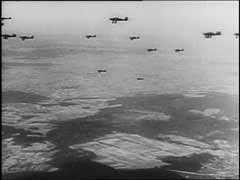
The German-Soviet Pact of August 1939 included a nonaggression pact whereby Germany and the Soviet Union promised not to attack one another for 10 years. Germany was thus able to invade Poland on September 1, 1939, without fear of Soviet intervention. In accordance with secret provisions of the pact, Poland was partitioned between Germany and the Soviet Union. Soviet forces occupied eastern Poland. In this footage, German and Soviet forces meet along the Bug River in central Poland. Less than two years…
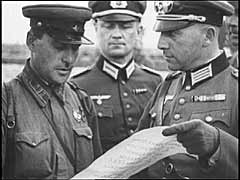
US forces liberated the Buchenwald concentration camp in Germany in April 1945. Here, US soldiers escort German civilians from the nearby town of Weimar through the Buchenwald camp. The American liberating troops had a policy of forcing German civilians to view the atrocities committed in the camps.
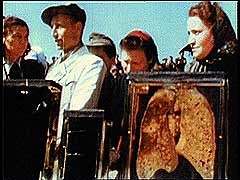
Germany invaded Poland on September 1, 1939, beginning World War II. German forces swiftly overran Polish border defenses and approached Warsaw, Poland's capital city. Warsaw suffered heavy air attacks and artillery bombardments during the campaign. The city surrendered on September 28. This footage shows German forces entering Warsaw amidst the destruction caused by their bombardment of the city.
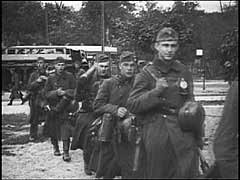
Allied forces occupied most of Germany by the end of April 1945. German forces fighting in Italy were the first to surrender unconditionally to the Allies. Representatives of the German command in Italy signed the surrender on April 29, and it became effective on May 2, 1945. Five days later, on May 7, 1945, Germany surrendered unconditionally to the western Allies, ending the war in Europe.
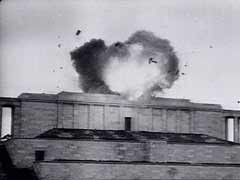
Germany invaded France in May 1940. This footage shows German tanks, artillery, and divebombers attacking the Maginot Line, a series of French fortifications intended to protect France's border with Germany. The main German assault, however, went to the north through Luxembourg and bypassed the Maginot Line. German forces entered Paris on June 14, 1940. Little more than a week later, defeated France signed an armistice with Germany.
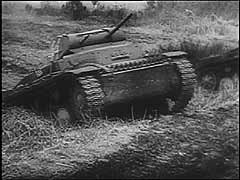
Germany invaded Norway on April 9, 1940, simultaneously attacking Norway's coastal cities from Narvik in the far north to Oslo in the south. Despite Allied naval superiority, German naval forces played an important role in the campaign. This footage shows German naval units sailing towards Norway in rough seas. German victory in Norway secured access to the North Atlantic for the German navy, especially the submarine fleet, and safeguarded transports of Swedish iron ore for Germany's war industry.
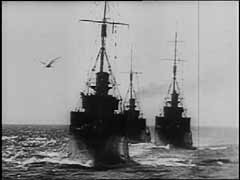
Germany invaded Norway on April 9, 1940, simultaneously attacking Norway's coastal cities from Narvik in the far north to Oslo in the south. Narvik was the scene of fierce battles between German forces and the Allies, who landed troops by sea in support of the Norwegians. Narvik changed hands several times. However, British, French, and Polish forces were finally withdrawn in June 1940 due to the success of the German campaign in western Europe. German victory in Norway secured access to the North Atlantic…
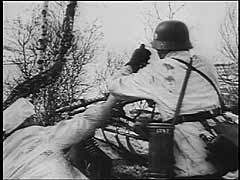
France signed an armistice with Germany on June 22, 1940, recognizing the right of German authorities to oversee the French administration. Further, German military authorities held jurisdiction over matters of internal security. In this footage, a German military court in Paris tries French citizens charged with resisting measures of the military occupation. Despite harsh military justice, the Germans could not quell opposition in France, and resistance activities would reach a peak during the Allied…

Germany launched its western offensive on May 10, 1940. German paratroopers landed in the Netherlands on the first day of the German attack on that country. They seized key bridges and fortifications, compromising Dutch defensive positions. This footage shows the German air force (Luftwaffe) dropping paratroopers near Rotterdam. Within days, the Netherlands was defeated. The country surrendered to Germany on May 14. The Dutch government and Queen Wilhelmina fled to exile in Great Britain.
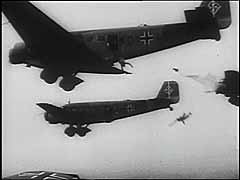
Denmark signed a nonaggression pact with Germany in 1939, hoping to maintain neutrality as it had in World War I. Germany, however, broke the agreement on April 9, 1940, when it occupied Denmark. King Christian X remained on the throne, and the Danish police and government reluctantly accepted the German occupation. This footage shows the German presence in the occupied Danish capital, Copenhagen. In 1943, as German policies towards Denmark toughened, the Danes would form one of the most active and…
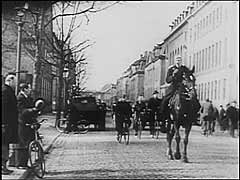
Germany invaded Poland on September 1, 1939. The Blitzkrieg ("lightning war") campaign in Poland was short and decisive. Polish forces in Warsaw, the capital of Poland, officially surrendered on September 28. In early October, Adolf Hitler visited Warsaw to review German forces. This footage shows German army units parading before Hitler in the streets of the devastated Polish capital.
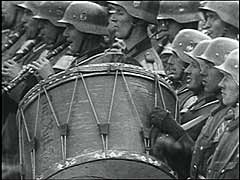
On the night of November 14-15, 1940, almost 500 German bombers attacked the British industrial city of Coventry in central England. The bombers dropped 150,000 incendiary bombs and more than 500 tons of high explosives. The air raid destroyed much of the city center, including 12 armament factories and the historic Saint Michael's Cathedral. This footage shows scenes from the aftermath of the attack. The bombing of Coventry came to symbolize, to Britain, the ruthlessness of modern air warfare.
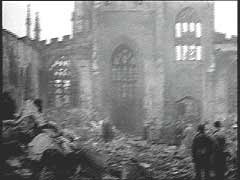
This footage from German newsreels shows German forces in action during the invasion of Poland.
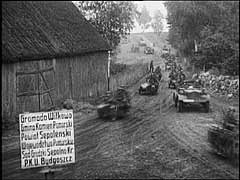
Adolf Hitler's foreign policy aimed at establishing a European empire for Germany through war. This policy required the rapid expansion of Germany's military capabilities. The Geneva Disarmament Conference, beginning in 1932, sought to avoid another European war by negotiating a reduction in armaments. Hitler repudiated this effort by withdrawing Germany from the conference in October 1933. At the same time, he rejected collective security in international affairs by withdrawing from the League of Nations.…
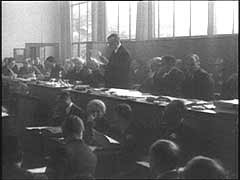
This footage shows Joseph Goebbels, Nazi minister for propaganda and public education, speaking at the September 1935 Nazi Party Congress in Nuremberg. In the speech, Goebbels—a fanatic antisemite—linked Bolshevism with international Jewry and warned Nazi party members of an alleged international Jewish conspiracy to destroy western civilization. Goebbels led the purge of Jewish and other so-called "un-German" influences from the cultural institutions of Nazi Germany.
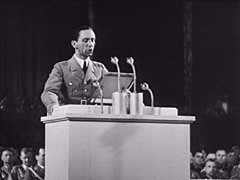
We would like to thank Crown Family Philanthropies, Abe and Ida Cooper Foundation, the Claims Conference, EVZ, and BMF for supporting the ongoing work to create content and resources for the Holocaust Encyclopedia. View the list of donor acknowledgement.